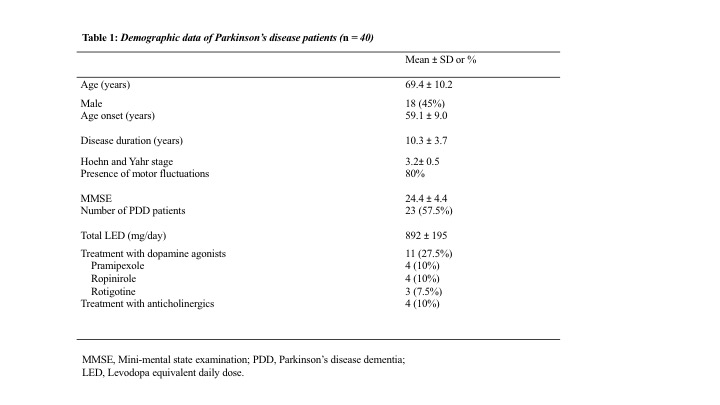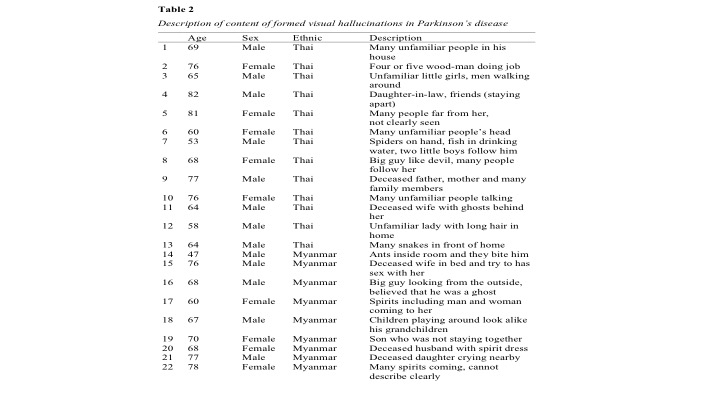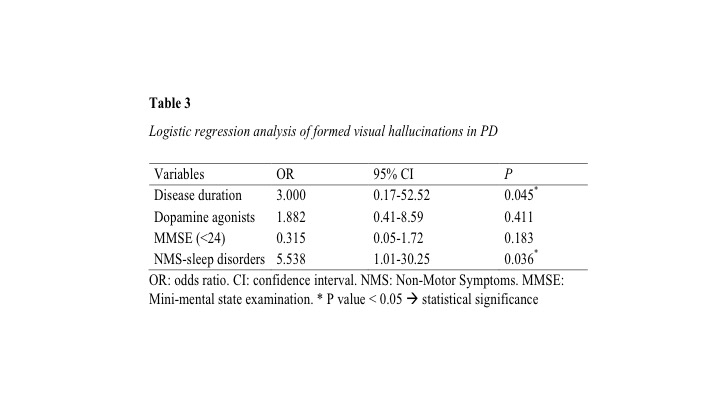Session Information
Date: Monday, October 8, 2018
Session Title: Parkinson's Disease: Non-Motor Symptoms
Session Time: 1:15pm-2:45pm
Location: Hall 3FG
Objective: To describe the phenomenology of visual hallucinations in Myanmar and Thai PD patients.
Background: Visual hallucinations are frequently reported by Parkinson’s disease (PD) patients, but the contents can also be influenced by social and cultural ambience.
Methods: This pilot study involved PD patients from Yangon General Hospital, Myanmar and Chulalongkorn University Hospital, Thailand. Patients who reported visual hallucinations were invited for structured interview to explore the nature and properties of their hallucinations. Clinical demographics were also obtained in all subjects.
Results: A total of 40 PD patients (Myanmar-16, Thai-24) with a mean age of 69.4±10.2 years were included. The mean disease duration was 10.3±3.7 with a mean MMSE score of 24.4±4.4 and H&Y stage of 3.2±0.5. The majority of patients (68%) had formed visual hallucinations, described as seeing of familiar or unfamiliar persons (35%), deceased relatives (12%), spirits or ghosts that related to their cultures (12%), animals (10%) and others.The descriptions of visual hallucinations show in table 2.The onset was most frequently reported in the evening or during the night (68%). 62% of episodes occurred a few times weekly and the duration was seconds to minutes in most cases (73%). Twenty patients (50%) experienced black and white images whereas the rest had color hallucinations. We found significant predictive factors of formed visual hallucinations with a longer disease duration (OR 3.0) and the presence of NMS-sleep disorders (OR 5.5).
Conclusions: The most common phenomenology of visual hallucinations among our study populations was formed hallucinations with a lack of insight, similar to previous literature. The characteristics of visual hallucinations were same between Myanmar and Thai patients for similar in culture and religion. Further studies should be performed to explore the detailed properties of visual hallucinations with a reference to cultural and social ambience on patients from different regions.
References: 1. Gilles Fénelon, Florence Mahieux, Renaud Huon and Marc Ziégler. Hallucinations in Parkinson’s disease, prevalence, phenomenology and risk factors. Brain (2000), 123, 733-745. 2. Jun Zhu, Bo Shen, et al. Prevalence and risk factors for visual hallucinations in Chinese patients with Parkinson’s disease. Journal of the Neurological Sciences, 372 (2017), 471-476.
To cite this abstract in AMA style:
Z. Shwe, J. Sringean, E. The, W. Thit, R. Bhidayasiri. The phenomenology of visual hallucinations in Parkinson’s disease: A descriptive analysis of Myanmar and Thai patients [abstract]. Mov Disord. 2018; 33 (suppl 2). https://www.mdsabstracts.org/abstract/the-phenomenology-of-visual-hallucinations-in-parkinsons-disease-a-descriptive-analysis-of-myanmar-and-thai-patients/. Accessed April 20, 2025.« Back to 2018 International Congress
MDS Abstracts - https://www.mdsabstracts.org/abstract/the-phenomenology-of-visual-hallucinations-in-parkinsons-disease-a-descriptive-analysis-of-myanmar-and-thai-patients/



